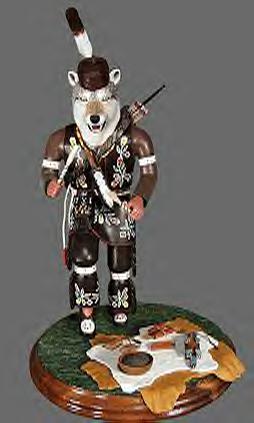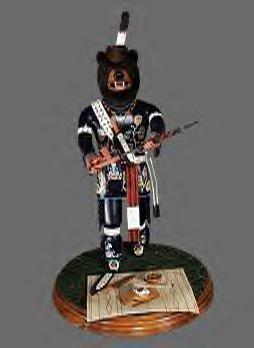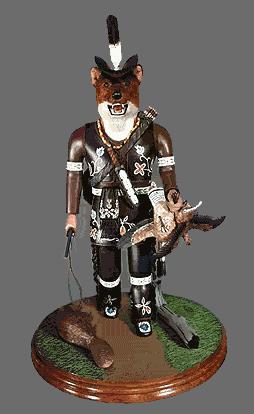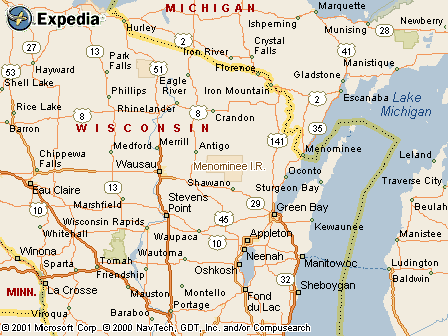|
|
Canku Ota |
|
|
(Many Paths) |
||
|
An Online Newsletter Celebrating Native America |
||
|
August 25, 2001 - Issue 43 |
||
|
|
||
|
The Menominee Clans Story |
||
|
© 2001 University
of Wisconsin-Stevens Point |
 The
Little Menominee The
Little Menominee The Menominee Clans Story displays wood figures carved by the Menominee traditional artist, James F. Frechette, Jr. Known by the Menominee as The Little Menominee, the intricately carved and painted figures stand between twelve and twenty inches high. Through an indigenous art form of the tribe, Mr. Frechette faithfully captures the cultural dimensions of the ancient clan system depicting dress, symbols, tools, colors, traditions, and many details of the now fast fading way of life. The Clan System Thirty-four clans, grouped into five distinct divisions called brothers, characterized traditional Menominee society in their homeland of what is now called Wisconsin. The Menominee Clans Story depicts a figure for each clan, plus a centerpiece set of six portraying the clans in council, along with the Menominee Genesis figures, The Great Light-Colored Bear, and The Golden Eagle. The Menominee Clans Structure Menominee culture developed the clan system as a means to address vital issues that the tribe faced. The origin story has as its heart the description of the process whereby the clans came into being, their order and function within the society. It articulates the creation of five Brothers or principal clans as organs through which the culture flowed and-life attained meaning. Each Brother assumed specific responsibilities within the tribal whole; the culture manifested itself through their considered actions. As each assisted the culture, in turn, it sustained them.  The Bear assumed the duties of civil administration throughout the tribe. The Eagle took as its
lot war, fire carrying, and camp laborers. The Wolf pursued hunting, and the Crane construction obligations. The
Moose accepted as his duty camp security, overseeing of the wild rice beds, supervising rice harvest and distribution.
To some extent the Younger Brothers shared in these tasks, although most, in turn, had other specific obligations
for their clan; the Sturgeon, for example, were Historians in addition to being Younger Brother to the Bear. The Bear assumed the duties of civil administration throughout the tribe. The Eagle took as its
lot war, fire carrying, and camp laborers. The Wolf pursued hunting, and the Crane construction obligations. The
Moose accepted as his duty camp security, overseeing of the wild rice beds, supervising rice harvest and distribution.
To some extent the Younger Brothers shared in these tasks, although most, in turn, had other specific obligations
for their clan; the Sturgeon, for example, were Historians in addition to being Younger Brother to the Bear.Purposes of the Exhibit Several purposes combined to impel the decision to acquire the figures. First, The Little Menominee belong to art as such. Secondly, Mr. Frechette's stature in the traditional Indian art world enhances the worthiness of the art component. He has been recognized as a significant artist whose work has been purchased and commissioned by museums, collectors, and citizens. Equally as important, the Exhibit itself will preserve an important cultural aspect of the traditional Menominee world, now slowly disintegrating into the shadows of today's plastic and steel civilization. Mr. Frechette is one of the few Menominee who still labors in the traditional forms and who also has knowledge of the ancient clan system. His participation guarantees quality and continuity with authenticity.  The educational element is very strong. Not only does the clan system project serve the university community in a score of academic and general ways, it also presents for Menominee youth an opportunity to visit and study and enhance their knowledge of an illustrious past. To the general public, both Wisconsin citizens and tourists, the clans is a unique opportunity to view the heritage of an Indian nation and to learn the complex ways of an ancient system. At the same time, the Menominee Clans Exhibit dovetails into the mission of the University of Wisconsin: to study the present and define it for the future. The Little Menominee clan carvings symbolize individual aspects of all human life, showing that harmony can be achieved by seeing the complexity and significance of a system devised by the Menominee to help guide their lives. |
|
|
|
Menominee Clans Story |
|
|
||
|
|
||
| Canku Ota is a free Newsletter celebrating Native America, its traditions and accomplishments . We do not provide subscriber or visitor names to anyone. Some articles presented in Canku Ota may contain copyright material. We have received appropriate permissions for republishing any articles. Material appearing here is distributed without profit or monetary gain to those who have expressed an interest. This is in accordance with Title 17 U.S.C. section 107. | ||
|
Canku Ota is a copyright © 2000, 2001 of Vicki Lockard and Paul Barry. |
||
|
|
|
|
|
The "Canku Ota - A Newsletter Celebrating Native America" web site and its design is the |
||
|
Copyright © 1999, 2000, 2001 of Paul C. Barry. |
||
|
All Rights Reserved. |
||

